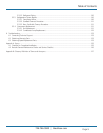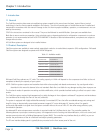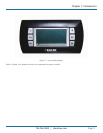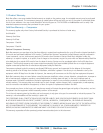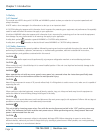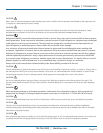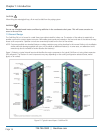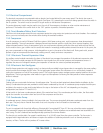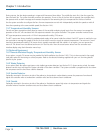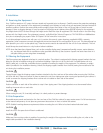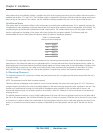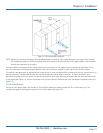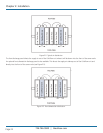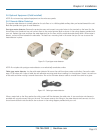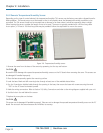
724-746-5500 | blackbox.com
724-746-5500 | blackbox.com
Page 17
Chapter 1: Introduction
1.5.1 Electrical Compartment
The electrical components are protected inside an electric box located behind the rear access panel. The electric box cover is
safety interlocked with the service disconnect switch (See Figure 1-2), preventing the cover from being opened when the switch in
the On position. The switch must be turned Off to gain access to the electrical compartment.
The service disconnect switch may be used to turn the unit off for emergency shutdown or when routine maintenance is
performed. The handle of the switch locks in the “Off” position to prevent unintended operation.
1.5.2 Circuit Breakers/Motor Start Protectors
Cold Row units incorporate state-of-the-art component protection using motor start protectors and circuit breakers. If an overload
occurs, you must manually reset the switches after clearing the overload condition.
1.5.3 Compressor
A scroll compressor is used in DX-based Cold Row systems. With fewer moving parts, scroll compressors have demonstrated
superior durability. The scroll compressor is designed around two identical spirals or scrolls that, when inserted together, form
crescent-shaped pockets. During a compression cycle, one scroll remains stationary while the other scroll orbits around the first.
As this motion occurs, gas is drawn into the scrolls and moved in increasingly smaller pockets toward the center. At this point, the
gas, now compressed to a high pressure, is discharged from a port in the center of the fixed scroll. During each orbit, several
pockets of gas are compressed simultaneously, creating smooth, nearly continuous compression.
1.5.3.1 Electronic Thermal Expansion Valve
An auxiliary control module mounted to the door of the electric box manages the operation of the electronic expansion valve
(EEV). The control module manages the EEV based on input signals from the suction pressure and temperature sensors. It
regulates the amount of refrigerant entering the evaporator to maintain the correct superheat temperature.
1.5.3.2 Electronic Hot Gas Bypass
Used for freeze protection and capacity control, an electronically controlled hot gas bypass valve is managed by the same auxiliary
control module that manages the EEV valve. The hot gas bypass system allows the compressor to run continuously instead of
cycling the compressor on and off for capacity control. The hot gas bypass system manages system capacity based on the suction
temperature. The hot gas regulator valve meters hot gas into the evaporator coil during low load periods or when evaporator
airflow is reduced.
1.5.4 Coils
Cooling coils are constructed of aluminum finned/copper tube. The coils are leak tested and cleaned before installation by the
factory. Condensate drain pans are provided to collect water condensed by the coils. A condensate pump empties the drain pans
and directs the water to a pipe stub located either at the top or the bottom of the A/C unit depending on the piping
configuration (see Section 2.7.1 and 2.8.1.1).
A float switch in the lower condensate pan detects if the water level rises. If the condensate pan fails to drain, the float switch
signals the controller to sound an alarm and turn off the compressor and the fans.
1.5.5 Condensate Pump
A condensate pump is factory installed in the lower drain pan. The pump automatically eliminates condensate water from the
drain pan. The pump has an internal float switch that turns the pump on and off based on the water level.
1.5.6 EC Fans
The unit is equipped with three high-efficiency, Electronically Commutated (EC) fans. EC fans use a brushless motor equipped
with permanent magnets and permanently lubricated ball bearings. The fan impellers are curved backward and attached to the
rotor casing. The fan is balanced and aerodynamically optimized to minimize vibration.
The fans do not use drive belts. Fan speed is variable via a 0- to 10-VDC signal from the system controller. The fan motor is
equipped with integral electronics and does not require the addition of secondary electronics such as thermal protection,
inverters, or filters. The fan will not produce AC inverter whine.



